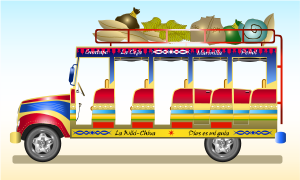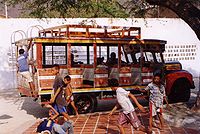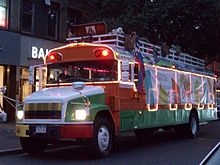- Rustic bus
-
Chiva Bus 
Also called Escalera Bus (Ladder Bus) Production First modification 1922 Class Bus Layout Front-engine, rear-wheel drive layout Platform Blue Bird, Dodge, Ford,among others Engine Diesel Transmission Manual transmission Designer Luciano Restrepo, Roberto Tisnes[1]
Rustic buses are old artisan modified buses used in rural Colombia and Ecuador where they are known as chivas (kid goats) or escaleras (ladders). They are used as public transport and more recently used as party buses in both countries. These are varied but characterized for being painted colorfully (usually with the yellow, blue, and red colors of the flags of Ecuador and Colombia) with local arabesques and figures. Most have a ladder to the rack on the roof which is also used for carrying people, livestock and merchandise.[2]They are built upon a bus chassis with a modified body made out either metal or wood. Seats are bench alike, made out of wood and with doors instead of windows. The owner or driver usually gives the vehicle a unique nickname.[2]
Contents
History
Culture of
Colombia
Art
Cinema
Cuisine
Dance
Folklore
Literature
Music
Radio & Television
Sports
TheaterChivas were first introduced in the Antioquia Department in the early 20th century. Peasants of the region usually relied on horse-drawn vehicles for the transportation of goods and themselves. In 1908 Colombian engineer Luciano Restrepo and Colombian mechanic Roberto Tisnes imported a chassis from the United States. In Medellin they built the first body. This first bus was used in a route between downtown Medellin to the town of El Poblado. The first models were very basic, with a canvas-made roof and four benches. The body of newer models were modified with a roof rack so peasants could transport their goods.
There is no official account of when this kind of bus first arrived in western Antioquia. In the book 'Memories of my land' (Memorias de mi tierra), Colombian writer Alirio Diaz tells about the first vehicles ever to arrive in Antioquia through the Las Palmas Road. The most reliable account is found in the book 'Notes for the History of San Vicente' (Apuntes para la Historia de San Vicente) where Colombian author Ricardo Zuluaga Gil narrates the arrival of the first chiva:
“ There was an event that altered the heyday of Saint Vicentians:The arrival to the town in 1922 of the first engine powered automobile. It was an escalera truck. It was brought from Rionegro by Mr. Lino Arbelaez by riding on the old Royal road for this they needed spades and shovel.[3] ” The term escalera (ladder) was coined because the buses have a ladder, usually located on the rear of the bus. This ladder allows people to put their belongings and goods on top of the bus. The bus became a rural solution to the need of moving both cargo and passengers simultaneously. The most particular and substantial feature of this buses is the combination of wood and metal. However, the aesthetic interpretation given through the years to this buses became the most cultural trademark of rural Colombia in the early 20th century. This aesthetic approach to a tool that became of utmost importance to the peasants developed naturally and some of them have as of today evolved into actual pieces of art.[4]
Symbol of Colombia and controversy
Chivas are recognized nationally and internationally as a symbol of Colombian culture, in particular of rural Colombia. On the other hand, they have been controversial and a subject of criticism. The main reason being that chivas rather than being a symbol of Colombia's diverse urban and rural culture, they are instead a symbol of underdevelopment and of the rustic hacking of a machine intended to be used in urban areas.
Today
As of today, chivas or escalera buses are still used as the main transportation system in very poor and isolated rural areas of Colombia, however, in most places they are slowly being replaced by newer, faster and more efficient minibuses. In the cities they have found a service as party buses especially in warmer cities. They are also combined with advertising for promotional campaigns and as tourist attractions. Currently, these vehicles also are used in various parts of Colombia as walking clubs, provided a good sound equipment, disco lights, microphone, to dance tracks and other accessories that make them look more Rumba and special for example one company that has adapted this type of vehicle is "chivas & travel Colombia " since 1998, comes with this particular variation and also to adapt them for tourism, entertainment and culture, has designed programs education, for poor children also can be used not only for fun, if not, to learn like a classroom, there, children and know their city travel, learning, mathematics, social, Spanish, standards citizen behavior, driving laws, among others. http://www.tuschivas.com/index.php?option=com_expose&Itemid=8[5] The "Jeepao" is a similar version of the chiva, but in a Willies Jeep.
Other locales
Not only can these unique buses be found in South America, but also other locales including the United States. As the population of Colombian Americans and Ecuadorian Americans has risen in New York City, New York; so has the use of this customized bus. Developed into party buses equipped with their own bar, these can often be found carrying partygoers around the city. Drew Barrymore, Lucy Liu and Cameron Diaz arrived in a Chiva for the New York premiere of “Charlie’s Angels.” [6]
See also
References
- ^ http://docs.google.com/viewer?a=v&q=cache:8zKC0pO_aDQJ:inforiente.info/index2.php%3Foption%3Dcom_content%26do_pdf%3D1%26id%3D3077+bus+escalera+historia&hl=en&gl=us&pid=bl&srcid=ADGEESgFYg-6EHG9CJlT1y2J5iP0kMXqRDJNlPfiKzy745ZgWQm5MkeNd5AOCUYIrVFMkxzfXe4uOIS_IlAa-D2xxrcKWXZUYKX4WQSzIouVd8JzYsBWjhH5A3wEEwa0Up3ShAoaBF7x&sig=AHIEtbSHyzkxofbZ-YPIUz-O9E8BEp4kGg
- ^ a b (Spanish) Revista Semana: La chiva semana.com Accessed 16 September 2007.
- ^ http://docs.google.com/viewer?a=v&q=cache:8zKC0pO_aDQJ:inforiente.info/index2.php%3Foption%3Dcom_content%26do_pdf%3D1%26id%3D3077+bus+escalera+historia&hl=en&gl=us&pid=bl&srcid=ADGEESgFYg-6EHG9CJlT1y2J5iP0kMXqRDJNlPfiKzy745ZgWQm5MkeNd5AOCUYIrVFMkxzfXe4uOIS_IlAa-D2xxrcKWXZUYKX4WQSzIouVd8JzYsBWjhH5A3wEEwa0Up3ShAoaBF7x&sig=AHIEtbSHyzkxofbZ-YPIUz-O9E8BEp4kGg Historic account by Emiro Marin Carvajal
- ^ http://www.rldiseno.com/index2.php?option=com_content&do_pdf=1&id=606 Carrocerias de los Buses y el diseno industrial.
- ^ Nelson Quiroga, Guia turistico
- ^ Vega, Tanzina (2008-03-02). "A Taste of Colombia Rolls Through New York’s Streets". The New York Times. http://www.nytimes.com/2008/03/02/nyregion/02chiva.html. Retrieved 2009-11-06.
Categories:
Wikimedia Foundation. 2010.





